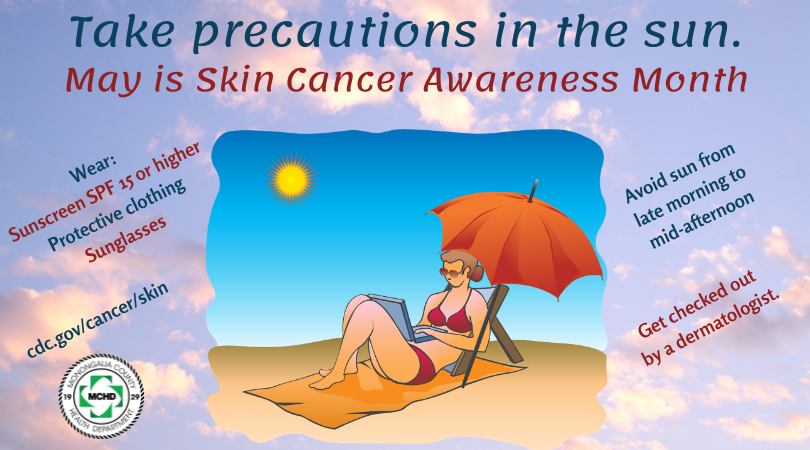Every month should be Skin Cancer Awareness Month

May. 21, 2022
By Katie Minor
My very first job was as a lifeguard in high school. Most of my time was going to be spent lounging in the sun or cooling off in the pool, and I was eager to finally get the golden summer tan always wanted.
Except golden summer tans don’t come naturally for pale 16-year-olds with Irish backgrounds. I went out for my first shift in the sun in a one-piece with virtually no SPF, no hat and a pair of cheap sunglasses. I spent the rest of the summer looking like Larry the Lobster.
Sunburns fade, blisters heal, but my skin will never fully recover from how I treated it that summer. Hindsight (with UV-blocking sunglasses, of course) is 20/20.
Most of last summer’s festivities were put on hold due to COVID-19, meaning this summer is the time to get some fresh air and have fun. After over a year of being indoors, though, it is more important than ever to protect yourself against the dangers of the sun, and Skin Cancer Awareness Month is a great time to go over some simple facts.
Skin cancer is the most common form of cancer in the U.S., though most forms are treatable. According to the CDC, about 4.3 million adults are treated for basal cell and squamous cell carcinomas each year.
So, what’s the difference between these types of skin cancer? Basal and squamous cell carcinomas are the two most common forms of skin cancer, which begin in the upper layers of the skin. Both of these carcinomas can almost always be cured, although they can cause disfigurements and be expensive to treat.
The third and most deadly type of skin cancer is melanoma, which begins deep inside the skin, and can spread throughout the body.
Skin cancer is usually caused by overexposure to ultraviolet or UV rays. UV rays can be good for you in moderation; it stimulates production of vitamin D, and the act of soaking up the sun outdoors is just a general mood-booster. But once your skin has reached its limit of vitamin D, your risk for skin cancer just keeps going up.
As someone with fair skin, I use a daily moisturizer with SPF 15 on my face, and usually use sunscreen with an SPF of at least 30 if I’m outside. If I’m spending a lot of time in the sun, I will go up to SPF 50 or 100 to protect myself and reapply every few hours.
If you still want that summer tan but you just can’t stop yourself from getting burnt, try a tinted moisturizer! It’s much safer than exposing yourself to harmful UV rays from the sun or tanning beds.
If you have darker skin, a daily SPF of 8-14 can still protect your skin from excessive UV rays, and try SPF 30-50 if you are spending the day in the sun. Other precautions against skin cancer include wearing a hat, long sleeves, sunglasses and staying in the shade.
Do you suspect you have melanoma? Remember the A-B-C-D-Es of melanoma:
A. Asymmetrical. Does the mole or spot have an irregular shape with two parts that look very different?
B. Border. Is the border irregular or jagged?
C. Color. Is the color uneven?
D. Diameter. Is the mole or spot larger than the size of a pea?
E. Evolving. Has the mole or spot changed during the past few weeks or months?
If you have a family member who can help conduct an inspection periodically to see if you have any strange moles, that’s one way to keep an eye on the situation. Sometimes dermatologists hold free skin cancer checks. But if you are concerned, you should discuss it with your doctor. Because most cases are treatable, it’s important that you speak up if anything looks odd.
Have a great summer, enjoy the weather, and don’t forget the sunscreen!
Katie Minor is a public information office intern at Monongalia County Health Department.